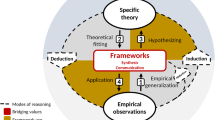Abstract
This research sought to facilitate improved stakeholder analysis in mining by providing further insights into the preferences of local community members using discrete choice theory. While recent research has demonstrated the usefulness of discrete choice theory in mining stakeholder analysis, no previous work has examined which discrete choice model (DCM) is most suitable. This paper provides a research note on a case study in a mining community that was performed to compare three DCMs. After a thorough examination of the benefits and deficiencies of all models, this study concludes that the conditional logit model stratified by questions is the most useful DCM for mining stakeholder analysis. The recommendation is based on the usefulness and accuracy (ability to match the survey data) of this model.
Similar content being viewed by others
Notes
Percent concordant—the percent of pairs in which their corresponding prediction probability for the observation with the desirable event is higher than the non-event ones.
Percent discordant—the percent of pairs in which their corresponding prediction probability for the observation with the desirable event is lower than the non-event ones.
Percent tied—the percent of pairs in which their corresponding prediction probability for the observation with the desirable event is equal to the non-event ones.
References
Browne AL, Stehlik D, Buckley A (2011) Social licences to operate: for better not for worse; for richer not for poorer? The impacts of unplanned mining closure for “fence line” residential communities. Local Env 16:707–725
Chen X, Liu X, Li F (2013) Comparative study on mode split discrete choice models. J Mod Transp 21:266–272. https://doi.org/10.1007/s40534-013-0028-5
Davis R, Franks DM (2011) The costs of conflict with local communities in the extractive industry. In: First international seminar on social responsibility in Mininig. Sanitiaco, CHILE, pp 1–13
Hensher DA, Rose JM, Li Z (2012) Does the choice model method and/or the data matter? Transportation (Amst) 39:351–385 https://doi.org/10.1007/s11116-011-9329-x
Hoyos D (2010) The state of the art of environmental valuation with discrete choice experiments. Ecol Econ 69:1595–1603
ICMM (2012) Mining’s contribution to sustainable development – an overview. Mining’s contribution to sustainable development
IFC (2007) Stakeholder engagement: a good practice handbook for companies doing business in emerging markets. IFC, Washington, DC, USA
Ivanova G, Rolfe J (2011) Assessing development options in mining communities using stated preference techniques. Resour Policy 36:255–264. https://doi.org/10.1016/j.resourpol.2011.03.001
Ivanova G, Rolfe J, Lockie S, Timmer V (2007) Assessing social and economic impacts associated with changes in the coal mining industry in the Bowen Basin, Queensland, Australia. Manag Environ Qual An Int J 18:211–228. https://doi.org/10.1108/14777830710725867
Mariel P, Meyerhoff J (2016) Hybrid discrete choice models: gained insights versus increasing effort. Sci Total Environ 568:433–443. https://doi.org/10.1016/j.scitotenv.2016.06.019
Mcfadden D, Train K (2000) Mixed MNL models for discrete response. Journal Appl Econom 15:447–470
Moffat K, Zhang A (2014) The paths to social licence to operate: an integrative model explaining community acceptance of mining. Resour Policy 39:61–70. https://doi.org/10.1016/j.resourpol.2013.11.003
Prno J, Scott Slocombe D (2012) Exploring the origins of ‘social license to operate’ in the mining sector: perspectives from governance and sustainability theories. Resour Policy 37:346–357. https://doi.org/10.1016/j.resourpol.2012.04.002
Que S (2015) Describing local community acceptance with discrete choice theory for enhanced community engagement. Missouri University of Science and Technology, Doctoral Dissertations Paper 2416
Que S, Awuah-Offei K (2014) Framework for mining community consultation based on discrete choice theory. Int J Min Miner Eng 5:59–74
Que S, Awuah-Offei K, Wang L, Samaranayake VA, Weidner N, Yuan S (2018) Individual preferences for mineral resource development: Perspectives from an urban population in the United States. J Clean Prod 189:30–39
Que S, Awuah-Offei K, Weidner N, Wang Y (2017) Discrete choice experiment validation: a resource project case study. Journal Choice Model 22:39–50. https://doi.org/10.1016/j.jocm.2017.01.006
Que S, Awuah-Offei K, Demirel A, Wang L, Demirel N, Chen Y (2019) Comparative study of factors affecting public acceptance of mining projects: evidence from USA, China and Turkey. J Clean Prod 237:117634
SAS (2014) The LOGISTIC Procedure: STRATA Statement [WWW Document]. SAS Inst. Inc., Cary, NC, USA
Thomson I, Boutilier RG (2011) Social license to operate. In: Darling P (ed) SME mining engineering handbook. pp 1779–1796
Train K (2002) Discrete choice methods with simulation. Cambridge University
Willis K, Scarpa R, Gilroy R, Hamza N (2011) Renewable energy adoption in an ageing population: heterogeneity in preferences for micro-generation technology adoption. Energy Policy 39:6021–6029. https://doi.org/10.1016/j.enpol.2011.06.066
Funding
This work was financially supported by the Key Laboratory of Western Mine Exploitation and Hazard Prevention, Ministry of Education (grant no. SKLCRKF1916), Natural Science Foundation of Chongqing (cstc2020jcyj-msxmX1000), and Venture and Innovation Support Program for Chongqing Overseas Returnees (grant no.cx2018114).
Author information
Authors and Affiliations
Corresponding author
Ethics declarations
Conflict of Interest
On behalf of all authors, the corresponding author declares no competing interests.
Additional information
Publisher's Note
Springer Nature remains neutral with regard to jurisdictional claims in published maps and institutional affiliations.
Appendices
Appendix 1 Survey methodology
Appendix 2 Full survey
Rights and permissions
About this article
Cite this article
Que, S., Awuah-Offei, K., Wang, Y. et al. An Empirical Comparison of Discrete Choice Models for Mining Stakeholder Analysis. Mining, Metallurgy & Exploration 39, 2121–2132 (2022). https://doi.org/10.1007/s42461-021-00522-8
Received:
Accepted:
Published:
Issue Date:
DOI: https://doi.org/10.1007/s42461-021-00522-8




